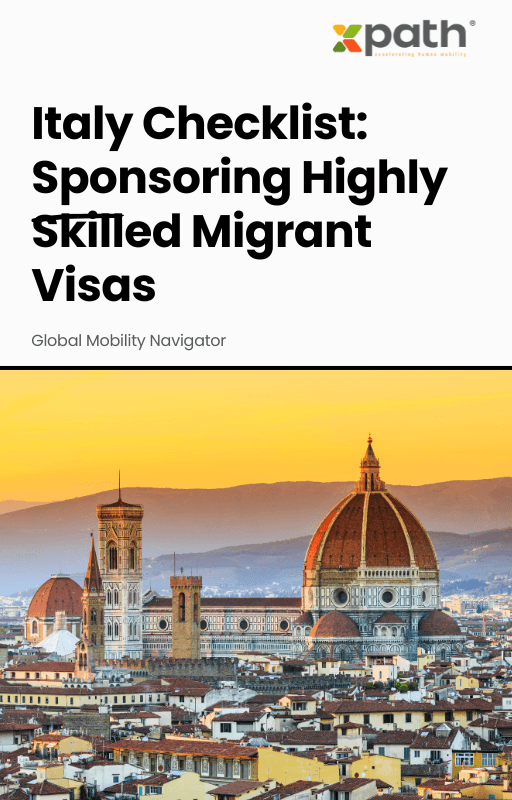Italy Checklist: Sponsoring Highly Skilled Migrant Visas
Grab a copy of a guide to international employee relocation
View E-bookWe’re living in a talent-driven economy. With approximately 281 million international migrants worldwide (UN Migration Data, 2023), businesses no longer confine the search for talent to local job boards. The rise of remote and hybrid work, international assignments, and cross-border teams has transformed employee movement into a strategic imperative. Yet, relocating employees isn’t just about moving boxes—it impacts talent retention, diversity, compliance, and even brand reputation.
Historically, global mobility programs were often reactive. An employee landed an assignment overseas, and HR would scramble to ensure visas, payroll, and housing were sorted. But with competition for skilled workers at an all-time high, the script has flipped: forward-thinking companies are leveraging data to make smarter, faster, and more people-centric mobility decisions.
Let’s be honest—mobility used to be a tactical afterthought. But today, it’s at the intersection of strategic HR, risk management, and data analytics. What’s fueling this shift? Digitization, increasing regulatory complexity, and the need to demonstrate ROI on talent mobility investments. In fact, a 2022 Deloitte Global Mobility Trends Survey found that nearly 70% of organizations now use mobility as a strategic lever to close skills gaps and accelerate business transformation.
Leading organizations are asking:
How can data help us predict assignment success?
Where can we optimize costs without sacrificing the employee experience?
Are we compliant in every geography?
By answering these questions, mobility teams earn a seat at the strategy table—no longer taskmasters, but essential growth partners.
So, what does “data-driven” global mobility look like in practice? Think real-time dashboards tracking everything from assignee satisfaction to assignment costs and tax exposures—available at the click of a button. According to a Mercer study, 64% of mobility professionals say analytics helps them demonstrate business value to leadership. However, only 22% feel fully equipped with the tools they need. That’s a massive opportunity gap.
Data layered from global platforms like xpath.global can offer insights across the mobility journey:
Who’s moving and why?
What are the regulatory risks in X country?
How do compensation and cost of living compare?
Where are process bottlenecks delaying assignments?
These analytics go beyond anecdotal feedback—they reveal patterns, predict hurdles, and ultimately allow HR to advise the business with confidence.
Let’s make this real. A global manufacturing giant faced soaring relocation costs and unpredictable assignment failures. By adopting an integrated mobility platform, it started tracking the correlation between pre-assignment assessments and assignment outcomes. The analysis was eye-opening: candidates with low adaptation scores were three times more likely to end assignments early, costing the company over $100K per failed placement. Armed with this insight, HR redesigned the candidate selection process—reducing assignment failures by 26% in just one year and unlocking substantial savings.
This isn’t an outlier. Companies using data to align benefits, compliance, and candidate fit saw faster time-to-deployment, smoother transitions, and higher retention in roles that matter to business objectives.
Of course, making the leap from manual spreadsheets to automated analytics isn’t a walk in the park. The top hurdles? Fragmented data sources, privacy concerns, and legacy systems that don’t play well together. There’s also the human factor: change management is crucial as teams reframe their roles from “doers” to “advisors.”
This is where centralized solutions like xpath.global shine—integrating vendor management, assignment tracking, document workflows, and custom analytics under one digital roof. Not only does this reduce errors, but it also liberates mobility specialists to focus on what matters: supporting people, advising leaders, and enabling business aspirations.
If you think today’s mobility tools are smart, just wait. We’re moving toward AI-driven personalization—powered by large, anonymized datasets and predictive modeling. Imagine being able to tailor policy choices to an individual’s profile, proactively flag assignment risks, or even automate compliance checks with a few clicks. As the mobility landscape gets more complex, agility will be everything. Companies that put real-time insights at the heart of their processes (rather than the periphery) will breeze ahead.
Let’s face it—talent doesn’t stay put, and neither should your strategy. By combining robust data analytics, digitized workflows, and the human touch, global mobility becomes so much more than a back-office function. It’s an engine for growth, innovation, and lasting business impact.
Curious how a platform like xpath.global can move your organization from tactical relocation to strategic talent mobility? It’s time to transform your employee mobility experience into a data-informed, compliance-assured, business-critical function.
What is a global mobility solution?
A global mobility solution is a set of processes and technologies designed to manage the relocation of employees across borders. It covers everything from immigration compliance and taxes to housing, payroll, and policy administration, ensuring a smooth and compliant move for both the assignee and the business.
Why is data important for global mobility?
Data allows organizations to make informed decisions about assignment selection, cost forecasting, compliance, and employee support. By leveraging analytics, companies can reduce risks, optimize budgets, and create more successful, satisfying relocation experiences.
How do platforms like xpath.global help streamline mobility programs?
Integrated platforms such as xpath.global centralize all aspects of global mobility—from vendor management and document workflows to analytics and compliance—saving time, slashing errors, and giving mobility leaders strategic oversight.
What are the main challenges in adopting a data-driven mobility strategy?
Key challenges include integrating data from multiple sources, safeguarding employee privacy, training teams to adapt to new technology, and balancing global policy with local compliance needs. Partnering with the right platform can help overcome these hurdles.
Ready to transform your mobility program? Explore xpath.global’s solutions.

Italy Checklist: Sponsoring Highly Skilled Migrant Visas
Grab a copy of a guide to international employee relocation
View E-book